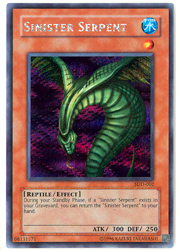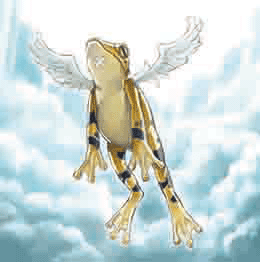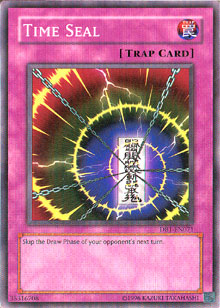 It took a while for most duelists to catch on to the magnificent powers of Sinister Serpent. After all, when the Stairway to the Destined Duel promo cards were released during the Beatdown era, card advantage was not highly valued.
It took a while for most duelists to catch on to the magnificent powers of Sinister Serpent. After all, when the Stairway to the Destined Duel promo cards were released during the Beatdown era, card advantage was not highly valued.
It seems unlikely that the card Treeborn Frog from the new Shadow of Infinity set will go without notice. In the same vein of Lightning Vortex succeeding Raigeki, and Brain Control following Change of Heart, Treeborn Frog is the spiritual successor to Sinister Serpent. This brings to mind a discussion that I once had with Evan Vargas during a dinner. Up for debate was the question of which monster was the best in the metagame during the April Forbidden list. The only two choices were Breaker the Magical Warrior and Sinister Serpent. Indeed, that should give you some indication of how good our beloved 1-star reptile was.
Now, it’s time to usher in its successor. Treeborn Frog is a 1-star monster with stats of 100 ATK and 100 DEF. You’re obviously not using this card for its attack or defense capabilities, so let’s take a look at its effect:
 If this card is in your Graveyard during your Standby Phase and there are no Spell or Trap Cards on your side of the field, you can Special Summon this card to your side of the field. This effect cannot be activated if there is a face-up "Treeborn Frog" on your side of the field.
If this card is in your Graveyard during your Standby Phase and there are no Spell or Trap Cards on your side of the field, you can Special Summon this card to your side of the field. This effect cannot be activated if there is a face-up "Treeborn Frog" on your side of the field.
Let’s first identify what it doesn’t do, then look at its strengths. The card doesn’t return to your hand like Sinister Serpent, so any combos involving things like Dark Word Lightning, Lightning Vortex, and others are not quite as sparkly. The card doesn’t provide direct hand advantage, which is generally held to be better than the field presence that Treeborn Frog does provide. To further limit its already tremendous potential, the developers wisely gave it a restriction—you can’t have any spell or trap cards on the field in order to use the effect.
What does a free “floater,” or free monster on the field, provide? The card does indeed allow you to unload free tribute monsters, making it great with cards like Mobius the Frost Monarch and Airknight Parshath. In this format that’s heavy with hand disruption, where cards like Spirit Reaper and Don Zaloog are looking for open fields to hit upon, Treeborn Frog looks like a failsafe defense mechanism. The opponent doesn’t want to waste a piece of monster removal on it, and can’t summon two monsters on the field, because then he or she will be risking Dark Hole or Torrential Tribute.
The second essential element that this card provides is defense. Treeborn Frog is basically a superior version of Foxfire, which was already a great card to begin with. Provided you have the condition to resolve its effect, you get a free defensive wall each turn.
After viewing its strengths, we can begin to derive an idea of what type of deck would best benefit from its use. The card is exciting because it is one of the best skill cards in the game, meaning those who are creative and skilled can squeeze the most use out of it. Sinister Serpent was probably the most combo-oriented card in the game, working with almost every discard cost, period. Treeborn Frog works in the same vein, and you can definitely use it with the same cards that Sinister Serpent loved. However, there are a few golden rules to keep in mind when using Treeborn Frog.
Three Steps to the Treeborn Frog Mantra
1. You want to get around its restriction by running lots of chainable spell or trap cards.
I’m talking about cards like Book of Moon, Enemy Controller, and Scapegoat. However, there are a few cards that are even better. You see, upon having the Frog in your graveyard, your opponent will realize that you can’t set up a defense. This means that he or she can passively set a monster and pass, or try to push with Spirit Reaper or Don Zaloog for damage, knowing you can’t stop it. Therefore, you want to fill your deck with traps and spells that can trigger at any time before your standby phase.
 I’m talking about cards like Dust Tornado, Waboku, and Time Seal. In fact, it wouldn’t be a bad idea to run three copies of Time Seal with three copies of Treeborn Frog. You can bluff your defense and trigger it during your draw phase. Time Seal provides the benefit of enabling the Frog’s effect while suggesting a defense.
I’m talking about cards like Dust Tornado, Waboku, and Time Seal. In fact, it wouldn’t be a bad idea to run three copies of Time Seal with three copies of Treeborn Frog. You can bluff your defense and trigger it during your draw phase. Time Seal provides the benefit of enabling the Frog’s effect while suggesting a defense.
Again, this card will take lots of skill and experimentation to use to its full potential. If you have one in the graveyard, you simply can’t set a spell or trap that turn that requires a trigger (like Sakuretsu Armor, Torrential Tribute, or Widespread Ruin). Also, you don’t want to force useless triggers to bring it out, like a Book of Moon at the end phase. There must be a balance between enabling its effect and doing it with spell or traps that actually help you. Time Seal and Dust Tornado both sound like great options.
2. A 1-star monster is useless unless you treat it as a “floater.”
“Floater” is a term that Yu-Gi-Oh! TCG players use to refer to monsters that have already paid for their cost. For example, a flipped Dekoichi the Battlechanted Locomotive costs one draw phase (to actually draw it), but basically pays for itself when you flip it. Now, if it attacks and your opponent uses something like Sakuretsu Armor on it, he or she actually loses a card. Because Dekoichi has already paid for itself and is a floater on the field, your opponent can’t harm it without using a monster to destroy it.
All flipped monsters that receive their effects are floaters. If Spirit Reaper or Don Zaloog causes a discard from the hand, they are also floaters. Because Spirit Reaper can’t be destroyed by battle, it almost requires a 2-for-1 trade upon hitting. That’s why Spirit Reaper is currently one of the best cards in this format. Upon using its effect to remove a monster, Chaos Sorcerer is also technically a floater, as are any monsters that destroy another through battle.
Now that we’ve gone through this, we realize that all floaters are created equal. If you use Chaos Sorcerer to sacrifice for Mobius, destroying two spell or trap cards, it provides the same net advantage as using Treeborn Frog! Therefore, the deck that takes full advantage of Treeborn Frog will either use lots of tribute monsters, or a lot of effects that require a monster on the field. Good examples include Share the Pain, Enemy Controller, and Dark Hole.
3. Plenty of testing will be needed to determine how many copies you will use.
Much like Pot of Avarice and Brain Control, Treeborn Frog will be difficult to place into a generic deck. The reason for this is that its effect will negate other copies in your hand. Running three copies might net you two in hand a few too many times, creating dead weight in your hand. Two might be the perfect number, but you might clamor for the advantage that three creates.
Playtesting will be needed to determine your favorite amount. I’ll use Royal Decree as a historical example. Duelists had problems deciding whether to run it in multiple copies. Because having a second copy in hand while the first is active is generally useless, most duelists decided to stick with two copies of the powerful trap. You saw very few builds running three copies, namely because it tended to nullify future copies drawn. Running one was not enough, three was too many, and two was just right.
Treeborn Frog might follow the same trend. It’s clearly the most exciting card to be released in the new set, and considering it’s simply a rare card, almost all serious duelists should be running to their local Sneak Preview events to net themselves a copy or three.